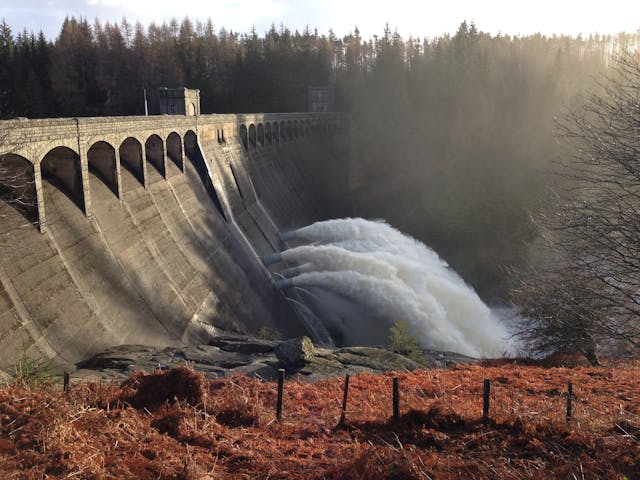
How does hydroelectric power work? Hydroelectric power works by converting the gravitational potential energy of stored water into kinetic energy, and then into electricity. As the first law of thermodynamics says, energy cannot be created or destroyed, only transformed from one type into another. This is what hydroelectric power does. A hydroelectric power station takes the kinetic energy that is in a stream of moving water and converts it into electricity, which is another form of energy.
Water flows into the hydroelectric power station and hits a turbine, which it spins. In the center of the turbine is a strong magnet and the magnet spins freely in a housing wrapped with wires. The magnet in the turbine creates a magnetic field, which interacts with the electrons of the atoms in the wire. If you spin the magnet, the polarity changes and the electrons are pushed backwards and forwards in line with the magnetic field. Each time they are pushed, they produce an electric current. The faster you can spin the magnetic field, the more electricity they produce. The kinetic energy in the water is used to spin the turbine, transferring the energy to the electrons in the wire. Not all of the energy goes to the wire, of course, because some will be lost in friction as heat, and in other places as well.
All moving objects have kinetic energy. To work out the kinetic energy of an object, you have to know the mass and the speed of the object. The formula is half the mass of the object multiplied by the square of the speed. So, let’s say you have an M4 Sherman tank (the most common US tank during World War 2) driving along at its top speed, which is 48 km/h. It is a tank, so it is pretty heavy. The top quoted mass for an M4 Sherman tank on Wikipedia is 38 tons, so we’ll use that. We want our units in kg and meters per second, so we have a mass of 38,000 kg and a speed of (roughly) 13 meters per second. So, half of the mass (38,000) is 19,000. The square of the velocity is 169. 19,000 multiplied by 169 is 3,211,000 and the unit of measurement for kinetic energy is joules, so our tank has a kinetic energy of 3.2 megajoules.
Working out the kinetic energy of a river is a little more complicated because it is not a solid object, like our Sherman tank example. When we are calculating the kinetic energy of a river, we only need to know the available energy at one point of the river, the point we are going to use, and not for the entire river. To calculate that, we work out the area of the river, to get the mass, and then calculate the speed, to give us the kinetic energy. However, there is a way to get a lot more energy out of a river and that is to speed up the water. Hydroelectric power stations don’t just put a turbine into a river. People did use waterwheels to grind corn and do other mechanical work, but they didn’t need a huge amount of energy. Hydroelectric power stations are almost always located in a dam, because damming a river is the way to get more power. When a river is dammed, the water builds up into a lake and the pressure in the water increases, giving it more potential energy. Then, the dam will have a narrow shoot for the water to go down, called the penstock. This is steep and dropping the water down from the lake to the turbines in a narrow pipe drastically increases the kinetic energy that can be used to spin the turbine.
Hydroelectric power stations produce 58% of all renewable energy in the world and they do it without producing carbon dioxide. They are very suitable for developing countries and they can theoretically produce electricity for as long as the river continues to flow. However, they are not without their problems. Damming a river to make a lake can have huge consequences for the ecosystem. It removes animal habitats and prevents them from using the river to travel past the point of the dam. The lake can also flood out agricultural land or communities. There is also the problem of greenhouse gases. The plants don’t produce carbon dioxide, but they do release a lot of methane into the atmosphere. The rotting plants at the bottom of the lake release methane, which is trapped in the lake water. When the water goes through the dam, a lot of that methane is released into the atmosphere. Currently, scientists are trying to find ways to capture that methane. And this is what I learned today.
Sources
https://www.bbc.co.uk/bitesize/articles/zcv4g7h#zxk38p3
https://www.tva.com/energy/our-power-system/hydroelectric/how-hydroelectric-power-works
https://www.nps.gov/articles/000/the-power-of-water-creating-energy.htm
https://en.wikipedia.org/wiki/Hydropower
https://www2.chem.wisc.edu/deptfiles/genchem/netorial/modules/thermodynamics/energy/energy2.htm
https://en.wikipedia.org/wiki/M4_Sherman
Photo by Travelling Tourist: https://www.pexels.com/photo/majestic-scottish-dam-with-powerful-water-flow-33346585/
